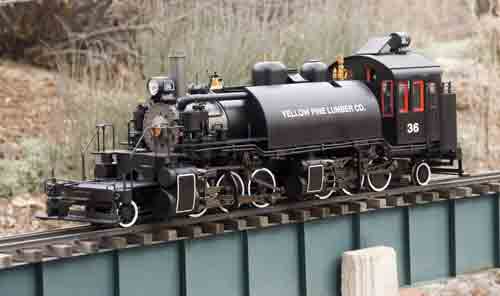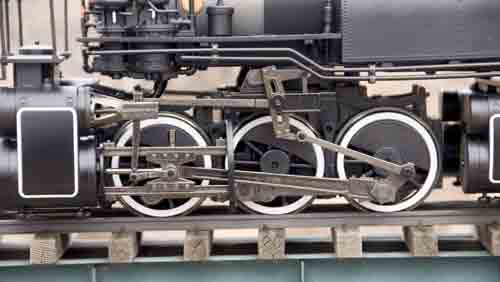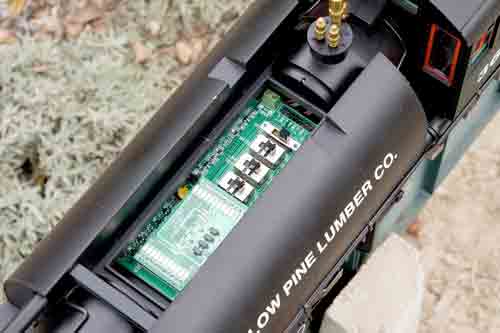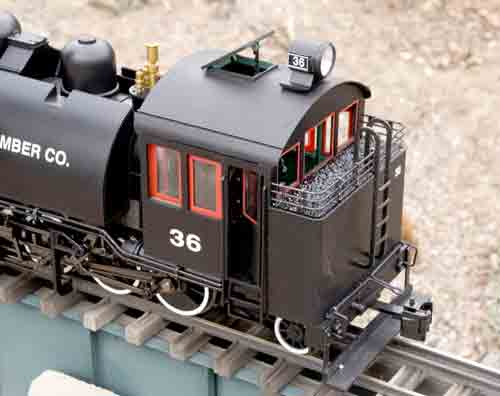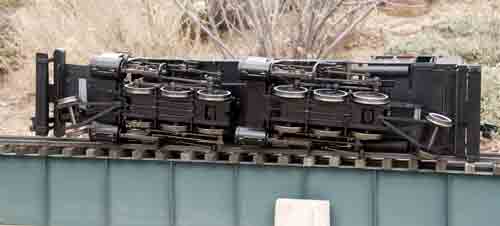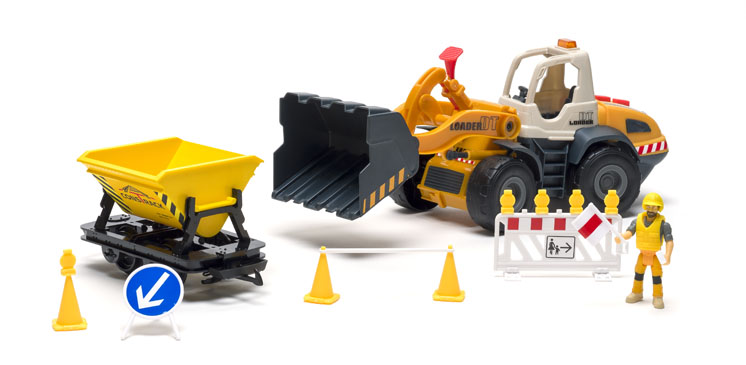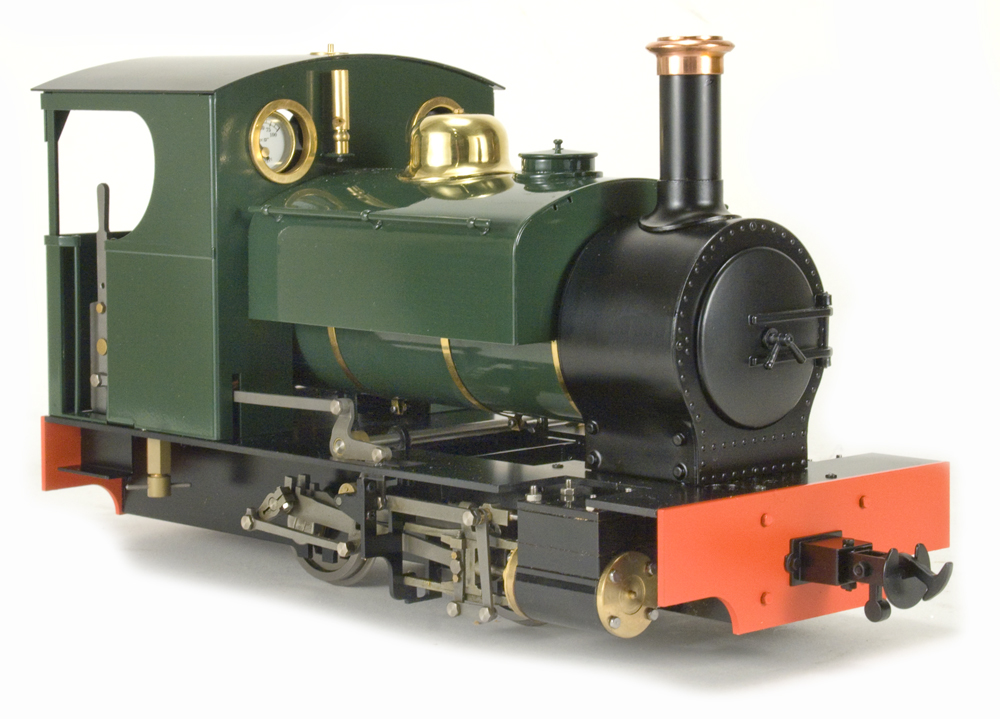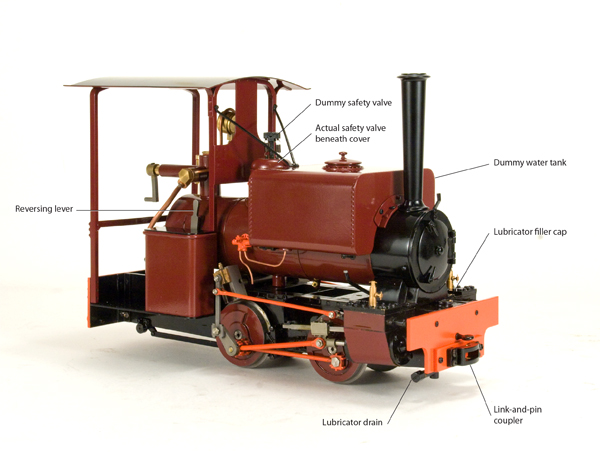Vital statistics
1:20.3 scale, gauge 1, 2-6-6-2T locomotive
Bachmann Industries
1400 East Erie Ave.
Philadelphia PA 19124
Price: $1,250
Web site: www.bachmanntrains.com
Electrically powered, plastic-and-metal model of a 2-6-6-2T logging locomotive; two pivoting power trucks; two 24V motors with flywheels and gearboxes; electrical pickup on all drivers; control switches for track/battery, polarity, motor on/off, firebox light; working knuckle couplers; DCC and R/C ready; interior cab detail; opening doors and windows; opening firebox door with fire flicker; directional lighting; smoke unit; various road names available; instructions, DVD, and extra-detail package included. Dimensions: length over end steps, 24″; width, 4¾”; height (over rear headlight), 7¾”. In 1:20.3 scale this works out to 40’7″ x 8’0″ x 13’1″, respectively. Weight: 12 pounds, 4 ounces
Pros: Beautifully executed model of an unusual locomotive; high level of detail; correct scale/gauge combination; excellent paint and graphics; good performance characteristics; lots of electronic features; easy access to electronics; diecast frames; all-metal valve gear and rods; robust construction-details don’t fall off with handling; complete set of exploded diagrams for entire locomotive supplied; comprehensive wiring diagram supplied; universal socket for third-party add-ons; center drive axles float; comprehensive instructions
Cons: Cab doors tend to flop open; no bell rope installed; internal electronics use space that might otherwise be used for batteries; bright-white LEDs used for headlights; top speed very fast; locomotive begins to move before headlight comes on
Straight out of the extremely well-packed box, this engine is impressive. The prototype was to be a Mallet-type of articulated locomotive. This meant that it would have two, separate steam motors beneath the boiler. True Mallets were all compound locomotives. The rear steam motor was the high-pressure engine (smaller cylinders). These exhausted to the low-pressure front steam motor (larger cylinders). Bachmann has faithfully modeled this aspect of the prototype.
However, on a Mallet, the rear motor would be attached rigidly to the boiler, forming an integral whole. The front motor would be attached to the rear motor by a hinge. The front motor could then support the forward part of the boiler, but still swing to help the engine around relatively tight curves.
It has become a convention with model-train manufacturers (in both large and small scales) to abandon this system. Instead, each steam motor is pivoted approximately in its middle, under the boiler. The purpose for this is to get the engine to negotiate ridiculously sharp and unprototypical curves. Toward that end, the system works, but it deprives the model of an important, prototypical characteristic, one that would be difficult for the average modeler to retrofit.
That aside, this is a fine model. Each steam motor has a large DC motor with a flywheel, geared to the axle via a 35:1 gear train. The center driver set on each chassis is sprung, allowing some up-and-down motion to help the engine over raggedy track. Side rods and valve-gear parts are all metal, and the side rods are articulated to accommodate the floating center axle. The valve gear itself is locked in the “neutral” position, so the valve rods do not work in and out. Lead and trailing trucks are sprung with little plungers that bear against the undersides of the frames. The rear coupler (which sticks out too far, prototypically) is self-centering in a system that allows it to maintain its distance from the end beam as it swings. The front coupler has neither of these features and is tied in with the motion of the leading truck. For the more fastidious modeler with wide-radius track, additional couplers are supplied that can be body mounted. The couplers themselves are somewhat oversize, but are nicely made, die-cast units with working knuckles. Cut levers are provided on the end beams but, because of the great swing of the couplers, these are not functional.
The cab has full interior detail that looks pretty good. In the extra-bits package is an engine crew consisting of one each of Bachmann’s toylike, 1:22.5-scale fireman and seated engineer (although I couldn’t find a place for him to sit). The engine, as supplied, is a coal burner, with coal in the bunker. If you don’t like that, an add-on is provided that will convert it into an oil burner. Replacement cab steps (with one more step) are also provided. In addition, there’s a tube of lubrication oil to go along with the comprehensive oiling instructions, and a bag of extraneous detail parts that really don’t measure up to the quality of this locomotive.
Inside the boiler, accessed by simply lifting off the top of the boiler section containing the two domes, are the electronics. There are four switches that control various functions, including motor on/off, firebox flickering, polarity, battery/track power, and DCC/DC. (Inside the smokebox door is another switch that tells the smoke unit whether it is being fed DC or DCC power.) Mounted to the same circuit board is a “dummy” DC board. If you are running track power and do not plan to add a sound system or DCC control, you need not worry about this-just leave it alone. To add sound or DCC, you must pop off this dummy board to reveal the “plug and play” socket below it, which will accept after-market circuit boards. If you have an after-market product that is not supported by the socket, Bachmann has also included a drop-in board that has lead wires and solder pads, to which you can wire your system. The instructions tell what each of the leads is for. For those installing sound systems, the engine comes with a built-in chuff sensor on the rear chassis. No speaker is provided, but there are instructions on how to install one.
The engine was tested on pure DC power applied to the track. No after-market products were employed. On the track, the engine performs well. It will begin to creep at around 3V. Slow-speed performance is excellent and speed control is good. Top speed, at 24V, is unprototypically fast, though. The flywheel action on the motor helps to provide extremely smooth operation. The down side to this is that the engine will not stop on a dime. Even in emergency mode, the engine will still take a foot or two to stop, depending on its speed. Drawbar pull was measured at two pounds and six ounces, or enough for around 30 average freight cars on straight, level track. This seems adequate, although I think that the tractive effort could be improved with the addition of some weight. At 24V, full slip, the engine drew only about 2.5 amps.
Directional lighting is featured. Headlights are equipped with bright-white LEDs, not light bulbs. They came on shortly after the engine began to creep, when voltage was applied slowly. These lights are too bright for my taste, and too white. Some transparent yellow lacquer might tone them down some.
Overall, this is an impressive locomotive. It is a model of an unusual prototype, it looks and runs great right out of the box, it offers lots of potential for add-on sound and control, and it should give kitbashers plenty of food for thought.





